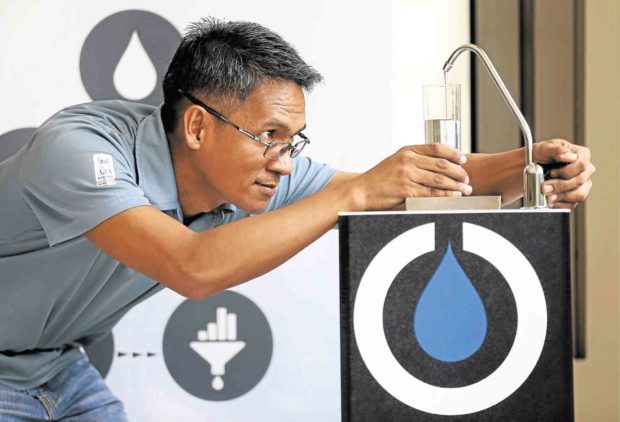Star Wars fiction becomes fact

Green Heat field engineer Jonell Capiz gets from an indoor water dispenser drinking water produced through Source Hydropanel technology, which uses sunlight and air to make potable water. —PHOTOS BY LYN RILLON
It took a long time to reach this galaxy, but “moisture farming” technology from the Star Wars universe has finally reached Philippine shores.
Zero Mass Water Inc. (ZMW), the American firm that developed the technology, calls it Source Hydropanels—a solar-powered device that produces drinking water by extracting water vapor from the air with an absorbent material dubbed Source.
ZMW’s catchphrase is that the completely off-grid and self-contained hydropanel creates drinking water “just from sunlight and air.”
The Arizona-based company has partnered with local solar power firm Green Heat Corp. and Asian Development Bank for a pilot deployment at ADB’s headquarters in Mandaluyong City.
Yongping Zhai, chief of ADB’s energy sector group, says the hydropanels will help address water supply problems in rural areas, especially in small islands, where there is no access to both reliable drinking water and electricity services.
“We hope that, through this pilot project, we can demonstrate the viability of this innovative technology,” says Zhai.
Cody Friesen, founder and chief executive of ZMW, says the hydropanel had been under development for the past six or seven years, and was first deployed in 2015 in Jordan.
Today, Source Hydropanels are used in 12 countries, including the Philippines.
The technology is reminiscent of a similar device described in the first Star Wars movie—Episode IV: A New Hope—where protagonist Luke Skywalker lived with his foster parents in a homestead in the arid planet of Tatooine.
The family makes a living by moisture farming—using a “moisture vaporator” to capture moisture from ambient air.
“Many Zero Mass staff are fans of Star Wars and they wanted to name our company with something from Star Wars,” Friesen tells Inquirer Business. “That didn’t happen.”
He says the Philippines’ geography makes it difficult to rely entirely on traditional water infrastructure.
“This makes it ideal for the Source technology to provide families, communities and businesses with drinking water,” he says.

Zero Mass Water Inc. has partnered with Green Heat Corp. and ADB for the pilot deployment of Source Hydropanels at ADB’s headquarters in Mandaluyong City. Celebrating the breakthrough are Green Heat GM Obeth Martin, Green Heat director Glenn Tong, Zero Mass Water founder and CEO Cody Friesen, ZMW marketing head Kaitlyn Fitzgerald and ZMW EVP for business development Robert Bartrop.
According to ZMW, two hydropanels can provide for a small family or small office while an array of three or more panels will be enough for an average family, office, school or community.
The hydropanel, which costs $2,000 each, includes photovoltaic wafers, air filters and water filters. Water vapor from the air around the panels is drawn into the Source—ZMW’s proprietary absorbent material.
With energy converted from sunlight, the moisture is then collected into an air-tight system and flows into a reservoir where it is mineralized with calcium and magnesium “for health and taste benefits.”
The drinking water passes through a cartridge (a filter) before being dispensed at a tap.
Friesen says each panel can produce five liters of water daily, and can put out up to 25,000 liters in its serviceable life. Of course, the air filter needs replacing yearly and the mineral cartridge every five years.
“A panel can last for a minimum of 15 years,” he says. “Source panels are connected to the [information technology] cloud, and are monitored in real time [from Arizona] so that we can see whether they are living up to our promise in terms of production and quality.”
Green Heat officials say that aside from the installation at the ADB’s premises, they are also working with the National Electrification Administration for the hydropanels’ deployment by eight electric cooperatives.
These are Pangasinan Electric Cooperative, First Bukidnon Electric Cooperative, Agusan del Sur Electric Cooperative, Davao del Sur Electric Cooperative, Bohol II Electric Cooperative, Samar II Electric Cooperative, Davao del Norte Electric Cooperative, and Misamis Occidental Electric Cooperative.
“We have experienced drinking water shortages here in the Philippines which is why we need to look into renewable solutions that won’t add strain to our already overburdened [infrastructure],” Green Heat director Glenn Tong says.
“Source is perfect for us because it’s a self-sufficient, low-maintenance technology and makes a great combination with other solar PV systems,” Tong adds.
